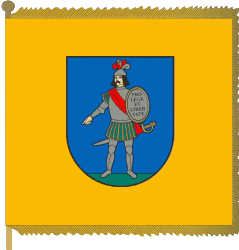Sakyna (Siauliai, Lithuania) (original) (raw)

This page is part of © FOTW Flags Of The World website
Last modified: 2023-06-03 by  zachary harden
zachary harden
Keywords: siauliai | sakyna |
Links: FOTW homepage |search | disclaimer and copyright | write us | mirrors

image by Virginijus Misiunas, 3 December 2009
See also:
Overview
From booklet: DISTRICT OF SIAULIAI AND ITS CONTEMPORARY HERALDRY [LaL02]:
"Sakyna - During the period of the Grand Dutchy of Lithuania the lands of Sakyna belonged to the Grand Duke. At the end of the 17th beginning of the 18th century the lands were ruled by Berg, Samogitian elder. At the end of the 18th or the very beginning of the 19di century the settlement was presented to count Lautreck, French emigree, by the Russian Emperor.
It is noted in some historical sources that Sakyna was granted the rights of Magdeburg Law in circa 1766 that were confirmed in 1791 and 1792 but no documents validate it. The recent research reveals the fact that in 1775 Sakyna was a settlement by the estate without trade privileges. Actually it was granted the city rights at the end of the Reform Parliament (the 4 Year Parliament, 1788-1792). Jonas Prekeris saw the original document of June 12, 1792, made a copy, which was handed over to the Jagela Library in Krakow. In the place of the present church built by Bishop Varanavicius, stood the one built on the initiative of Berg in 1680. The ensemble of the church and the cemetry chapel form a protected architectural monument. A primary school in Sakyna was opened in 1804, however, it was closed with the suppression of the 1863 uprising.
The number of the population in Sakyna varied from 223 in 1841 to 340 in 1923, to 373 in 1959, to 428 in 1987. Presendy the rural district of Sakyna includes 38 villages, the biggest of which is Zarenai with 1,800 inhabitants.
Sakyna is located by the river Sakyna 30 km west from Siauliai and 12 km from Gruzdziai.
The information about the Sakyna historical coat of arms from 1792 in the Lithuanian Collection of Legal Acts (metrika) states: "The town is granted the coat of arms which depicts the knight with a shield on which the motto "Pro Lege et Libertate" (To Justice and Freedom) is inscribed. The town is given the right to use the arms on its seal". The design is rather primitive - the knight clad in armour with a sword and a shield. Further hills and silhouettes of trees are covered with mist.
No evidences exist whether Sakyna used the arms in the 18th century as by that time the Reform Parliament opponents the Targovica Confederates demanded to close the self-governing units. The coat of arms was forgotten for a long time. The design of the arms was publicised in 1935 by the Polish researcher Marijanas Gumovskis for the first time but as he could not get hold of the original one deposited in Moscow, he depicted the knight with a sword in one hand and leaning on the gothic shield with the other with the inscription "Pro Lege et Libertate" (To Justice and Freedom).
Officialy the Sakyna coat of arms was recreated after 200 years. Following the heraldic principals the figure was simplified preserving the former composition and the main colours (design by Rolandas Rimkunas): the silver knight clad in armour pointing downwards with his hand and an oval silver shield (with golden frames) and the inscription in Latin "Pro Lege et Libertate" at his left shoulder on a field of azure. The knight's cloak and his right shoulder dressing are green with golden frames. The red sash across the right shoulder is tied to the silver sword with a golden hilt. The silver helmet is decorated with two red and two silver ostrich feathers. The knight's hair and moustache are black, his face and right hand are flesh coloured.
The Sakyna coat of arms was onfirmed by the President of the Republic of Lithuania on May 31, 1999."
Anon., 24 June 2003
Sakyna (Siauliai District) - On a yellow field the arms of Sakyna: an unmounted knight. Flag proportions 10:11, fringe is golden, finial is a golden knob. The arms, granted in 1791, should mean protection for the new town and its rights, but also it is a reminder that the country can be defended only by weapons.
Virginijus Misiunas, 3 December 2009
Coat of Arms

image by Anon., 24 June 2003